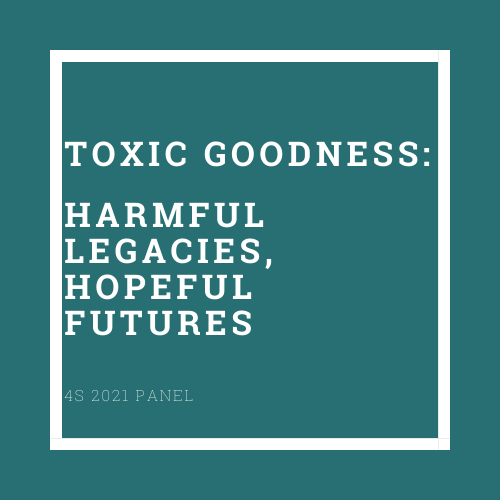
Chair: Jessica Caporusso
Discussant: Zoe Wool, University of Toronto
“Your Home is Your Biosphere”: Legacies of Gender and Race in the Domesticity of Alternative Technology - Emma Schroeder, University of Maine
Toxic Nutrients: The Politics of Harmful Algal Bloom Mitigation in Lake Erie - Gebby Keny, Rice University
Toxic Ash, Hopeful Leaves: Brazilian Sugarcane Histories and Biofuel Futures - Katie Ulrich, Rice University
When Sean Wellesley-Miller argued that “your home is your biosphere” in 1977, the alternative technology movement had garnered support from grassroots activists, national governments, and international agencies. Proponents imagined that constructing alternatives to ecologically destructive...Read more
Each summer, several hundred square miles of Lake Erie’s southwest basin are covered in a toxic pea-green slime that threatens drinking water supplies and depletes oxygen levels within lake waters, causing mass wildlife die-offs. These increasingly common and disruptive events are referred to as...Read more
Sugarcane scientists and industry actors in Brazil are working to expand the volume and scope of sugar-based fuels, chemicals, and other materials like bioplastic. They aim to reduce reliance on fossil fuels and mitigate problems like global warming through this versatile plant....Read more
Chair: Duygu Kaşdoğan
Discussant: Timothy Neale, Deakin University
Lesser Flamingo Life and Death: Nourishing Toxicity, ‘Generous’ Mines and Metabolic Transitions in Kimberley, South Africa - Carina Truyts, Sol Plaatje University
An Extractive Science? Complicated Industries and Crude Natures - Zsuzsanna Dominika Ihar, University of Sydney
Caring For and Living With Extractive Legacies in Northern Canada - Caitlynn Beckett, Memorial University of Newfoundland
Rethinking Plastic Realities: A call for a well-being approach to understanding human-plastic entanglements - Jessica Vandenberg, University of Washington; marlena skrobe; Jill Fallman, University of Washington; Karin Otsuka, University of Washington; Ivy Serwaa Gyimah Akuoko, University of Cape Coast; Suzy An, University of Washington
What makes a worthwhile object of care? Early in 2019 lesser Flamingo chick euphoria took hold of the small historical diamond mining city of Kimberley in central South Africa. A rapid, publicly driven rescue operation mobilized in response to the plight of thousands of baby flamingos, abandoned...Read more
221 hectares of hydrocarbon-contaminated soil reimagined as a promissory garden bed. The renaturalisation and bioremediation of Qara Şəhər (Black City) –a historic industrial district of Baku, Azerbaijan–, was launched by state and corporate investors in 2011. The intended outcome of the...Read more
This is a working paper to be presented at 4S 2021 Conference in the Panel "Toxic Goodness"Read more
The closure and waste management phases of a mine’s lifecycle have complex socio-economic and cultural impacts on local communities. Yet, the ongoing community care dimensions of these waste landscapes typically receive less attention than engineered containment solutions. Remediation projects...Read more
Presentation paper for 4S 2021, entitled "Caring For and Living With Extractive Legacies in Northern Canada"Read more
4S 2021 Presentation Slides, entitled "Caring For and Living with Extractive Legacies in Northern CanadaRead more
Plastics have emerged as the omnipresent material and challenge of the Anthropocene. Since the mid 20th century, a staggering amount of plastics have been produced, manufactured, used, disposed of and accumulated as waste in the environment. Despite their benefits, plastics are threatening the...Read more
Chair: Katie Ulrich
Discussant: Kim Fortun, University of California Irvine
Quicksilver’s Tales: Alchemical Histories and Contaminated Legacies - Ruth Goldstein
Tracing Critical Minerals Genealogies through Arizona’s Emerging Helium Boom - Kirk Jalbert, Arizona State University; J Richter, Arizona State University; Noa Bruhis, Arizona State University
From Mining to Phytomining: Bioinspired Practices and Hopeful Forms of Life in a Contaminated World - Lauren Kamili, EHESS/LAS/ADEME
Residual Ecologies: Finding Life within Extraction - Sebastian Ureta, Universidad Alberto Hurtado; Patricio Flores, University of Warwick, UK
This paper examines current extractive rainforest economies in the context of alchemical histories in artisanal and small-scale gold mining (ASGM) in Peru, with a focus on the Amazonian region of Madre de Dios. As part of an ongoing collaborative research project with gold miners,...Read more
4S paper: Quicksilver’s Tales: Alchemical Histories and Contaminated Legacies - Ruth GoldsteinRead more
In 2018 the U.S. Department of Interior took the unprecedented step of publishing a list of minerals deemed “critical” to national security and economic development. Alongside cobalt, uranium, and lithium, helium earned a place as the only gas included on this list. Helium is one of the...Read more
Paper presentation: Tracing Critical Minerals Genealogies through Arizona’s Emerging Helium Boom - Kirk Jalbert, Arizona State University; J Richter, Arizona State University; Noa Bruhis, Arizona State UniversityRead more
The former zinc mines in the village of Saint-Laurent-Le-Minier, located in the Gard region of southern France, have been closed since the 1990s. A jewel of French industry for a time, the mines and their closure have left neither the environment, whose waters and soils are now heavily...Read more
Paper - From Mining to Phytomining: Bioinspired Practices and Hopeful Forms of Life in a Contaminated World - Lauren Kamili, EHESS/LAS/ADEMERead more
The Carén River is a water stream located near Alhue, in central Chile. It would be completely unremarkable if it were not for one key aspect: it carries water throughout the year. Being located in a semi-arid region experiencing a decade-long megadrought, this characteristic has turned...Read more
Discussant remarks by Zoë Wool, presented at 4S 2021 Toxic Goodness Panel I (Ocotber 6, 2021)Read more